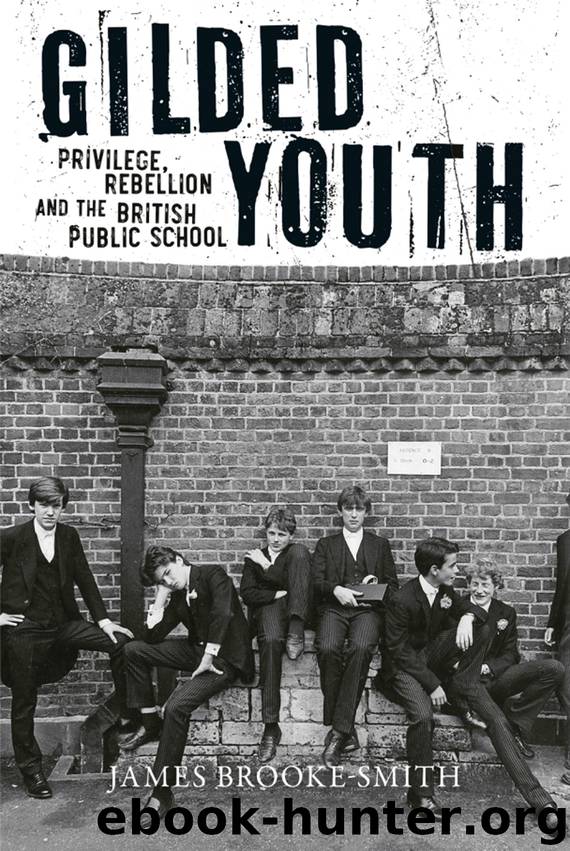Gilded Youth by James Brooke-Smith

Author:James Brooke-Smith
Language: eng
Format: epub
Publisher: Reaktion Books
Graves describes a semiotic system as bafflingly arcane and rigorously policed as the tattoos used by Russian criminal gangs to mark their allegiances and histories. Both of these systems are visual expressions of modern tribal societies; they encode the collective memory and social hierarchy of an enclosed, all-male world. Rather than pure expressions of individual identity, aesthete fashions were part of the wider symbolic economy of the school. They were ‘technical’ interventions that derived much of their meaning and radical charge from the very system they disrupted.
The aim of schoolboy aestheticism, claimed Henry Yorke, was ‘to arouse more than disdain, we were out to annoy by being what we called “amusing”.’15 Juvenility and playfulness were deployed as a self-conscious antidote to the school’s ethos of maturity and self-discipline. Louis MacNeice called this the ‘fashionable child cult’ and ‘the bacchanalian chorus of youth’.16 At Marlborough MacNeice teamed up with Betjeman and Blunt to form the Hereticks, an aesthete-intellectual club that published an eponymous magazine with the motto ‘Upon Philistia I will Triumph’. On the bright orange cover of the first edition was an image of a bewildered sportsman reeling from the attentions of a group of circling nymphs – a victory for art over athletics. The Hereticks performed a kind of running parody of the school’s sporting culture. They threw coloured balls at one another on the sidelines of rugby matches; during chapel services they dangled handkerchiefs from their lapels in parody of the obsession with winning school ‘colours’; and on occasion Betjeman would bowl a coloured hoop before him as he danced through the school grounds, a green feather lodged daintily behind his ear. At Lancing a similar revolt was enacted by Evelyn Waugh, Tom Driberg and their fellow members of the ‘Corpse Club’, who wore black ties, black tassels on their jackets and black buttonholes in their lapels, and corresponded on black-edged notepaper. Dubbed the ‘Bolshies’ by their more conventional schoolfellows, Waugh and his friends disrupted cadet corps exercises by parading in unclean or disorderly uniforms and contradicting the sergeant’s barked orders. The Corpse Club was founded ‘for those who are weary of life’, a motto which inverted the official school values of athletic prowess and physical health.17
The greatest success of Howard and Acton’s schoolboy careers was undoubtedly Eton Candle, an ‘ephemeral’, or single-issue, magazine they published in their final year. Both boys were precocious literary talents. By the age of sixteen Howard had published poems in Edith Sitwell’s Wheels and Charles Orage’s New Age, two impeccably cutting-edge modernist magazines. And while Acton had to wait until he was at university to have his first book of poetry published, his talents were nevertheless clear to his friends and teachers. Eton Candle was a glittering addition to the boys’ expanding portfolio of excellences, one that made waves beyond the little world of the school. The magazine garnered positive reviews in The Times, the Morning Post, the Daily Express, The Observer and the Sunday Times. It also earned the accolade of
Download
This site does not store any files on its server. We only index and link to content provided by other sites. Please contact the content providers to delete copyright contents if any and email us, we'll remove relevant links or contents immediately.
| Africa | Americas |
| Arctic & Antarctica | Asia |
| Australia & Oceania | Europe |
| Middle East | Russia |
| United States | World |
| Ancient Civilizations | Military |
| Historical Study & Educational Resources |
Life of Elizabeth I by Alison Weir(2026)
The Invisible Wall by Harry Bernstein(1767)
Art of Betrayal by Gordon Corera(1401)
1916 in 1966 by Mary E. Daly(1231)
Thunderstruck by Erik Larson(1183)
The Decline and Fall of the British Empire, 1781-1997 by Piers Brendon(1096)
A Brief History of Britain, 1066-1485 by Nicholas Vincent(1009)
A Brief History of Britain, 1485-1660 by Ronald Hutton(979)
Guy Burgess by Stewart Purvis(971)
Mary, Queen of Scots by Weir Alison(961)
Henry VIII by Alison Weir(909)
The Last Lion 02 - Winston Churchill - Alone, 1932-1940 by William Manchester(908)
Lang Lang by Lang Lang(833)
1066 by Andrew Bridgeford(829)
Gimson's Kings and Queens by Andrew Gimson(814)
The Last Plantagenet by Thomas B Costain(810)
Coalition by David Laws(809)
London: A Biography by Peter Ackroyd(804)
Diana by Andrew Morton(785)
